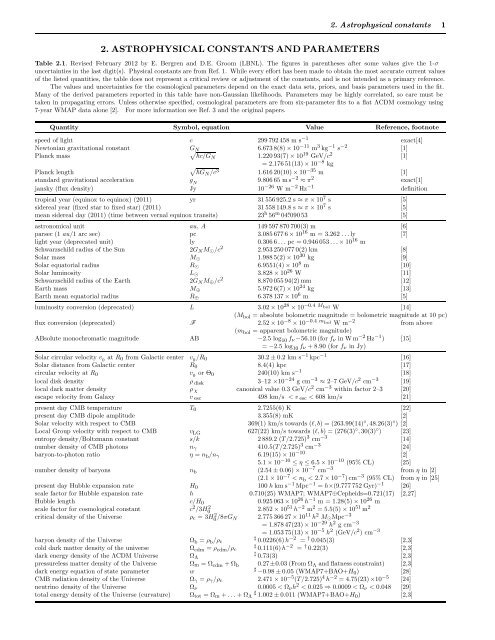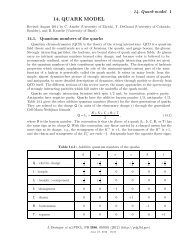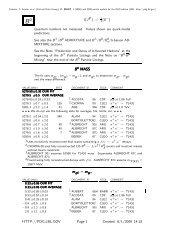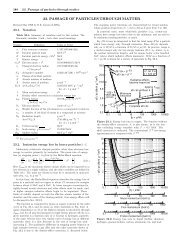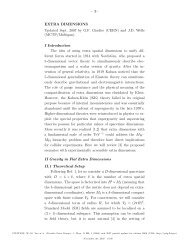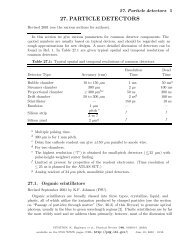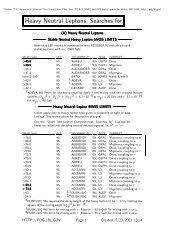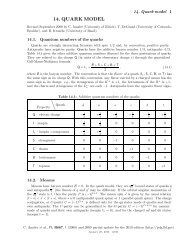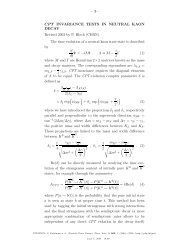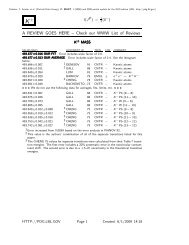2. astrophysical constants and parameters - Particle Data Group
2. astrophysical constants and parameters - Particle Data Group
2. astrophysical constants and parameters - Particle Data Group
You also want an ePaper? Increase the reach of your titles
YUMPU automatically turns print PDFs into web optimized ePapers that Google loves.
<strong>2.</strong> Astrophysical <strong>constants</strong> 1<br />
<strong>2.</strong> ASTROPHYSICAL CONSTANTS AND PARAMETERS<br />
Table <strong>2.</strong>1. Revised February 2012 by E. Bergren <strong>and</strong> D.E. Groom (LBNL). The figures in parentheses after some values give the 1-σ<br />
uncertainties in the last digit(s). Physical <strong>constants</strong> are from Ref. 1. While every effort has been made to obtain the most accurate current values<br />
of the listed quantities, the table does not represent a critical review or adjustment of the <strong>constants</strong>, <strong>and</strong> is not intended as a primary reference.<br />
The values <strong>and</strong> uncertainties for the cosmological <strong>parameters</strong> depend on the exact data sets, priors, <strong>and</strong> basis <strong>parameters</strong> used in the fit.<br />
Many of the derived <strong>parameters</strong> reported in this table have non-Gaussian likelihoods. Parameters may be highly correlated, so care must be<br />
taken in propagating errors. Unless otherwise specified, cosmological <strong>parameters</strong> are from six-parameter fits to a flat ΛCDM cosmology using<br />
7-year WMAP data alone [2]. For more information see Ref. 3 <strong>and</strong> the original papers.<br />
Quantity Symbol, equation Value Reference, footnote<br />
speed of light c 299 792 458 m s −1 exact[4]<br />
Newtonian gravitational constant G√ N 6.673 8(8) × 10 −11 m 3 kg −1 s −2 [1]<br />
Planck mass<br />
c/GN 1.220 93(7) × 10 19 GeV/c 2 [1]<br />
√<br />
= <strong>2.</strong>176 51(13) × 10 −8 kg<br />
Planck length<br />
GN /c 3 1.616 20(10) × 10 −35 m [1]<br />
st<strong>and</strong>ard gravitational acceleration g N<br />
9.806 65 ms −2 ≈ π 2 exact[1]<br />
jansky (flux density) Jy 10 −26 W m −2 Hz −1 definition<br />
tropical year (equinox to equinox) (2011) yr 31 556 925.2 s ≈ π × 10 7 s [5]<br />
sidereal year (fixed star to fixed star) (2011) 31 558 149.8 s ≈ π × 10 7 s [5]<br />
mean sidereal day (2011) (time between vernal equinox transits) 23 h 56 m 04 ṣ 090 53 [5]<br />
astronomical unit au, A 149 597 870 700(3) m [6]<br />
parsec (1 au/1 arc sec) pc 3.085 677 6 × 10 16 m = 3.262 . . .ly [7]<br />
light year (deprecated unit) ly 0.306 6 . . . pc = 0.946 053 . . . × 10 16 m<br />
Schwarzschild radius of the Sun 2G N M ⊙ /c 2 <strong>2.</strong>953 250 077 0(2) km [8]<br />
Solar mass M ⊙ 1.988 5(2) × 10 30 kg [9]<br />
Solar equatorial radius R ⊙ 6.9551(4) × 10 8 m [10]<br />
Solar luminosity L ⊙ 3.828 × 10 26 W [11]<br />
Schwarzschild radius of the Earth 2G N M ⊕ /c 2 8.870 055 94(2)mm [12]<br />
Earth mass M ⊕ 5.972 6(7) × 10 24 kg [13]<br />
Earth mean equatorial radius R ⊕ 6.378 137 × 10 6 m [5]<br />
luminosity conversion (deprecated) L 3.02 × 10 28 × 10 −0.4 M bol W [14]<br />
(M bol = absolute bolometric magnitude = bolometric magnitude at 10 pc)<br />
flux conversion (deprecated) F <strong>2.</strong>52 × 10 −8 × 10 −0.4 m bol W m −2 from above<br />
(m bol = apparent bolometric magnitude)<br />
ABsolute monochromatic magnitude AB −<strong>2.</strong>5 log 10 f ν −56.10 (for f ν in Wm −2 Hz −1 ) [15]<br />
= −<strong>2.</strong>5 log 10 f ν + 8.90 (for f ν in Jy)<br />
Solar circular velocity v 0<br />
at R 0 from Galactic center v 0<br />
/R 0 30.2 ± 0.2 km s −1 kpc −1 [16]<br />
Solar distance from Galactic center R 0 8.4(4) kpc [17]<br />
circular velocity at R 0 v 0<br />
or Θ 0 240(10) km s −1 [18]<br />
local disk density ρ disk 3–12 ×10 −24 g cm −3 ≈ 2–7 GeV/c 2 cm −3 [19]<br />
local dark matter density ρ χ canonical value 0.3 GeV/c 2 cm −3 within factor 2–3 [20]<br />
escape velocity from Galaxy v esc 498 km/s < v esc < 608 km/s [21]<br />
present day CMB temperature T 0 <strong>2.</strong>7255(6) K [22]<br />
present day CMB dipole amplitude 3.355(8) mK [2]<br />
Solar velocity with respect to CMB 369(1) km/s towards (l, b) = (263.99(14) ◦ , 48.26(3) ◦ ) [2]<br />
Local <strong>Group</strong> velocity with respect to CMB v LG 627(22) km/s towards (l, b) = (276(3) ◦ , 30(3) ◦ ) [23]<br />
entropy density/Boltzmann constant s/k 2 889.2 (T/<strong>2.</strong>725) 3 cm −3 [14]<br />
number density of CMB photons n γ 410.5(T/<strong>2.</strong>725) 3 cm −3 [24]<br />
baryon-to-photon ratio η = n b /n γ 6.19(15) × 10 −10 [2]<br />
5.1 × 10 −10 ≤ η ≤ 6.5 × 10 −10 (95% CL) [25]<br />
number density of baryons n b (<strong>2.</strong>54 ± 0.06) × 10 −7 cm −3 from η in [2]<br />
(<strong>2.</strong>1 × 10 −7 < n b < <strong>2.</strong>7 × 10 −7 )cm −3 (95% CL) from η in [25]<br />
present day Hubble expansion rate H 0 100 h km s −1 Mpc −1 = h×(9.777 752 Gyr) −1 [26]<br />
scale factor for Hubble expansion rate h 0.710(25) WMAP7; WMAP7⊕Cepheids=0.721(17) [2,27]<br />
Hubble length c/H 0 0.925 063 × 10 26 h −1 m = 1.28(5) × 10 26 m<br />
scale factor for cosmological constant c 2 /3H0 2 <strong>2.</strong>852 × 10 51 h −2 m 2 = 5.5(5) × 10 51 m 2<br />
critical density of the Universe ρ c = 3H0 2/8πG N <strong>2.</strong>775 366 27 × 10 11 h 2 M ⊙ Mpc −3<br />
= 1.878 47(23) × 10 −29 h 2 g cm −3<br />
= 1.053 75(13) × 10 −5 h 2 (GeV/c 2 ) cm −3<br />
baryon density of the Universe Ω b = ρ b /ρ c ‡ 0.0226(6)h −2 = † 0.045(3) [2,3]<br />
cold dark matter density of the universe Ω cdm = ρ cdm /ρ c ‡ 0.111(6)h −2 = † 0.22(3) [2,3]<br />
dark energy density of the ΛCDM Universe Ω Λ ‡ 0.73(3) [2,3]<br />
pressureless matter density of the Universe Ω m = Ω cdm + Ω b 0.27±0.03 (From Ω Λ <strong>and</strong> flatness constraint) [2,3]<br />
dark energy equation of state parameter w ♯ −0.98 ± 0.05 (WMAP7+BAO+H 0 ) [28]<br />
CMB radiation density of the Universe Ω γ = ρ γ /ρ c <strong>2.</strong>471 × 10 −5 (T/<strong>2.</strong>725) 4 h −2 = 4.75(23) ×10 −5 [24]<br />
neutrino density of the Universe Ω ν 0.0005 < Ω ν h 2 < 0.025 ⇒ 0.0009 < Ω ν < 0.048 [29]<br />
total energy density of the Universe (curvature) Ω tot = Ω m + . . . + Ω ♯ Λ 1.002 ± 0.011 (WMAP7+BAO+H 0 ) [2,3]
2 <strong>2.</strong> Astrophysical <strong>constants</strong><br />
Quantity Symbol, equation Value Reference, footnote<br />
fluctuation amplitude at 8 h −1 Mpc scale σ 8 † 0.80(3) [2,3]<br />
curvature fluct. amplitude at k 0 = 0.002 Mpc −1 ∆ 2 R<br />
<strong>2.</strong>43(11) × 10 −9 [2,3]<br />
scalar spectral index n ‡ s 0.963(14) [2,3]<br />
running spectral index slope, k 0 = 0.002 Mpc −1 dn s /d lnk ♯ −0.03(3) [2]<br />
tensor-to-scalar field perturbations ratio,<br />
k 0 = 0.002 Mpc −1 r = T/S ♯ < 0.36 at 95% CL [2,3]<br />
redshift at decoupling z dec † 1091(1) [2]<br />
age at decoupling t ∗ † 3.79(5) × 10 5 yr [2]<br />
sound horizon at decoupling r s (z ∗ ) † 147(2) Mpc [2]<br />
redshift of matter-radiation equality z eq † 3200 ± 130 [2]<br />
redshift of reionization z reion † 10.5 ± 1.2 [2]<br />
age at reionization t reion 430 +90<br />
−70 Myr [2,30]<br />
reionization optical depth τ ‡ 0.088(15) [2,3]<br />
age of the Universe t 0 † 13.75 ± 0.13 Gyr [2]<br />
‡ Parameter in six-parameter ΛCDM fit [2].<br />
† Derived parameter in six-parameter ΛCDM fit [2].<br />
♯ Extended model parameter [2].<br />
References:<br />
1. P.J. Mohr, B.N. Taylor, & D.B. Newell, CODATA Recommended<br />
Values of the Fundamental Constants: 2010, (to be published);<br />
physics.nist.gov/<strong>constants</strong>.<br />
<strong>2.</strong> N. Jarosik et al., Astrophys. J. Supp. 192, 14 (2011);<br />
D. Larson et al., Astrophys. J. Supp. 192, 16 (2011);<br />
E. Komatsu et al., Astrophys. J. Supp. 192, 18 (2011).<br />
3. O. Lahav & A.R. Liddle, “The Cosmological Parameters,” in this<br />
Review.<br />
4. B.W. Petley, Nature 303, 373 (1983).<br />
5. The Astronomical Almanac for the year 2011, U.S. Government<br />
Printing Office, Washington, <strong>and</strong> The U.K. Hydrographic Office<br />
(2010).<br />
6. While A is approximately equal to the semi-major axis of<br />
the Earth’s orbit, it is not exactly so. Nor is it exactly the<br />
mean Earth-Sun distance. There are a number of reasons: a) the<br />
Earth’s orbit is not exactly Keplerian due to relativity <strong>and</strong> to perturbations<br />
from other planets; b) the adopted value for the Gaussian<br />
gravitational constant k is not exactly equal to the Earth’s<br />
mean motion; <strong>and</strong> c) the mean distance in a Keplerian orbit is<br />
not equal to the semi-major axis a: 〈r〉 = a(1 + e 2 /2), where e is<br />
the eccentricity. (Discussion courtesy of Myles St<strong>and</strong>ish, JPL).<br />
7. The distance at which 1 A subtends 1 arc sec: 1 A divided by<br />
π/648 000.<br />
8. Product of 2/c 2 <strong>and</strong> the heliocentric gravitational constant<br />
G N M ⊙ = A 3 k 2 /86400 2 , where k is the Gaussian gravitational<br />
constant, 0.01720209895 (exact) [5]. The value <strong>and</strong> error for A<br />
given in this table are used.<br />
9. Obtained from the G N M ⊙ product [5] <strong>and</strong> G N [1]. .<br />
10. T. M. Brown & J. Christensen-Dalsgaard, Astrophys. J. 500,<br />
L195 (1998) Many values for the Solar radius have been<br />
published, most of which are consistent with this result.<br />
11. 4π A 2 × (1361 W m −2 ) [31]. Assumes isotropic irradiance.<br />
1<strong>2.</strong> Schwarzschild radius of the Sun (above) scaled by the Earth/Sun<br />
mass ratio given in Ref. 5.<br />
13. Obtained from the G N M ⊕ product [5] <strong>and</strong> G N [1]. .<br />
14. E.W. Kolb & M.S. Turner, The Early Universe, Addison-Wesley<br />
(1990);<br />
The IAU (Commission 36) has recommended 3.055 × 10 28 W for<br />
the zero point. Based on newer Solar measurements, the value<br />
<strong>and</strong> significance given in the table seems more appropriate.<br />
15. J. B. Oke & J. E. Gunn, Astrophys. J. 266, 713 (1983). Note<br />
that in the definition of AB the sign of the constant is wrong.<br />
16. M.J. Reid & A. Brunthaler, Astrophys. J. 616, 872 (2004)<br />
as corrected using new value for Solar proper motion in Ref. 18.<br />
Note that v ⊙ /R 0 is better determined than either Θ 0 or R 0 .<br />
17. A. M. Ghez et al., Astrophys. J. 689, 1044 (2008);<br />
S. Gillessen et al., Astrophys. J. 692, 1075 (2009);<br />
M. Shen & Z. Zhu, Chin. Astron. Astrophys. 7, 120 (2007). In<br />
their Fig.2 Zhu & Chin present a summary of a dozen values<br />
published 1984–2007. Most are closer to R 0 = 8.0(5) kpc than<br />
those cited above.<br />
18. C. McCabe, Phys. Rev. D82, 023530 (2010) Other papers report<br />
values closer to 220(20) km s −1 ;<br />
S.E. Koposov, H.-W. Rix, & D.W. Hogg, Astrophys. J. 712, 260<br />
(2010);<br />
P.J. McMillan & J.J. Binney, (2009) arXiv:0907.4685.<br />
19. G. Gilmore, R.F.G. Wyse, & K. Kuijken, Ann. Rev. Astron.<br />
Astrophys. 27, 555 (1989).<br />
20. Sampling of many references:<br />
M. Mori et al., Phys. Lett. B289, 463 (1992);<br />
E.I. Gates et al., Astrophys. J. 449, L133 (1995);<br />
M.Kamionkowski, A.Kinkhabwala, Phys. Rev. D57, 325 (1998);<br />
M. Weber, W. de Boer, Astron. & Astrophys. 509, A25 (2010);<br />
P. Salucci et al., Astron. & Astrophys. 523, A83 (2010).<br />
21. M. C. Smith et al., Mon. Not. R. Astr. Soc. 379, 755 (2007)<br />
(astro-ph/0611671 ).<br />
2<strong>2.</strong> D. Fixsen, Astrophys. J. 707, 916 (2009).<br />
23. D. Scott & G.F. Smoot, “Cosmic Microwave Background,” in<br />
this Review.<br />
24. n γ = 2ζ(3) ( ) kT 3<br />
π 2 <strong>and</strong> ρ γ = π2 (kT) 4<br />
c 15 (c) 3 c 2 ; kT 0<br />
c = 11.900(4)/cm.<br />
25. B.D. Fields, S. Sarkar, “Big-Bang Nucleosynthesis,” this Review.<br />
26. Conversion using length of sidereal year.<br />
27. Average of WMAP7 [2] <strong>and</strong> independent Cephid-based measurement<br />
by A.G. Reiss et al., Astrophys. J. 730, 119 (2011). Other<br />
high-quality measurements could have been included.<br />
28. R. Amanullah et al., Astrophys. J. 716, 712 (2010). Fit with<br />
curvature unconstrained. For a flat Universe, w = −1.00 ± 0.08.<br />
29. Ω ν h 2 = ∑ m νj /93eV, where the sum is over all neutrino mass<br />
eigenstates. The lower limit follows from neutrino mixing results<br />
reported in this Review combined with the assumptions that there<br />
are three light neutrinos (m ν < 45 GeV/c 2 ) <strong>and</strong> that the lightest<br />
neutrino is substantially less massive than the others: ∆m 2 32 =<br />
(<strong>2.</strong>43 ± 0.13) × 10 −3 eV 2 , so ∑ √<br />
m νj ≥ m ν3 ≈ ∆m 2 32 = 0.05 eV.<br />
(This becomes 0.10 eV if the mass hierarchy is inverted, with<br />
m ν1 ≈ m ν2 ≫ m ν3 .) Astrophysical determinations of ∑ m νj ,<br />
reported in the Full Listings of this Review under “Sum of the<br />
neutrino masses,” range from < 0.17eV to < <strong>2.</strong>3eV in papers<br />
published since 2003. Alternatively, if the limit obtained from<br />
tritium decay experiments (m ν < 2 eV) is used for the upper<br />
limit, then Ω ν < 0.04.<br />
30. If the Universe were reionized instantaneously at z reion .<br />
31. G. Kopp & J.L. Lean, Geophys. Res. Lett. 38, L01706 (2011).<br />
Kopp & Lean give 1360.8 ± 0.6Wm −2 , but given the scatter in<br />
the data we use the rounded value without quoting an error.


